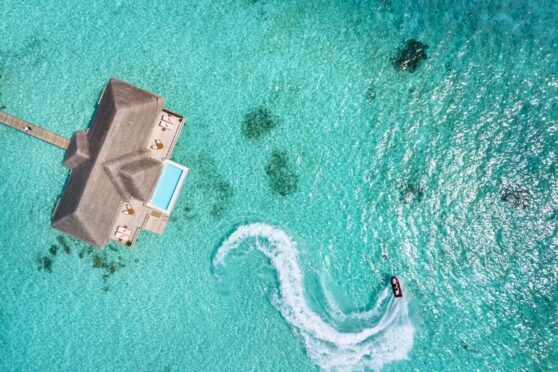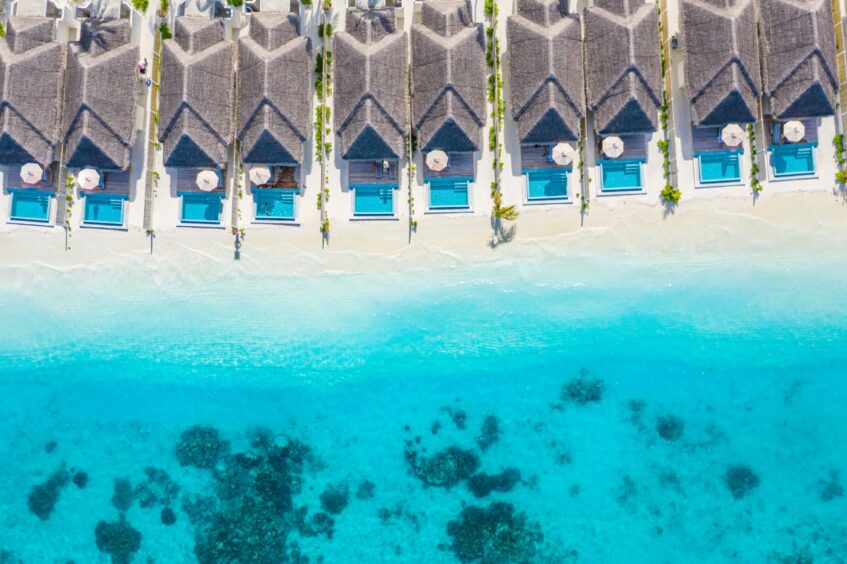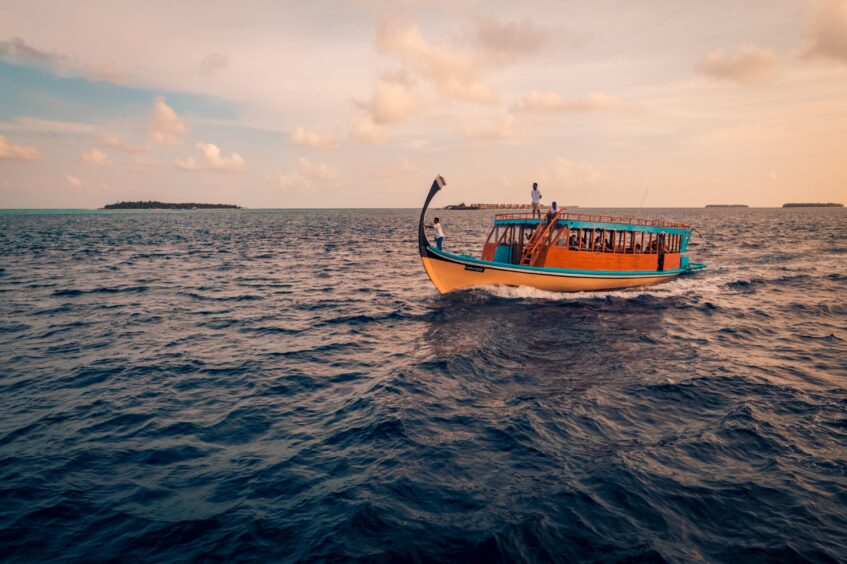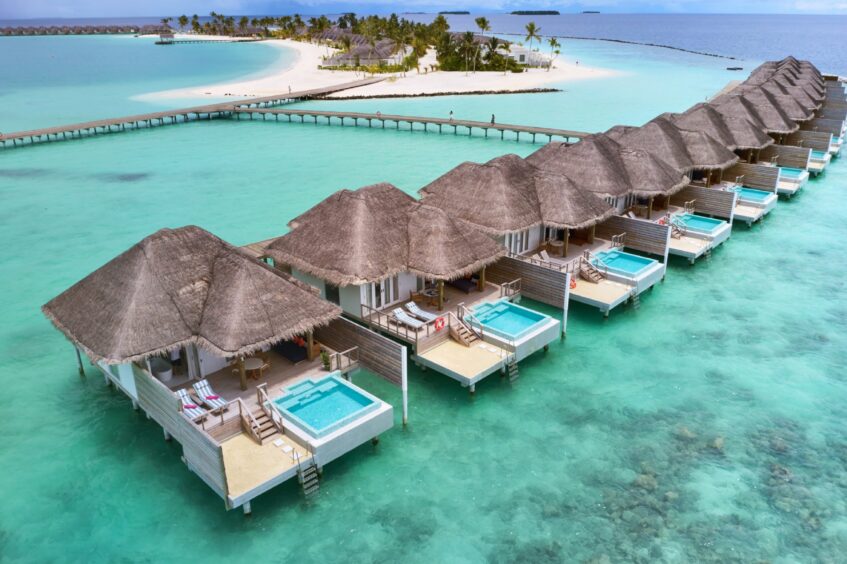
Not long after the small island-hopper took off from Noovilu Seaplane Terminal on Male, one of the world’s most breath-taking natural sights soon loomed into view.
With endless sugar-fine sands and aqua blue waters, the reef-ringed atolls of the Maldives are spectacular enough on the ground. But from the air, the hundreds of tropical islets that make up the Indian Ocean playground can be seen in all their glory as they unfold in front of you, like the iridescent eyes on the tail feathers of a peacock.
The jaw-dropping vista drew loud gasps from my fellow travellers, followed by a mad scramble to get the mobile phone cameras clicking. It was one of the standout highlights of a nine-day, twin-resort trip to the Maldives in May.
The 40-minute seaplane transfer from Male to the five-star Sun Siyam Iru Veli resort went past in a blur, courtesy of nature’s finest eye candy, and we were soon touching down on a turquoise lagoon for a three-night, all-inclusive stay.
Maldivian-owned and family run, the secluded private resort offers a sleek and spacious combination of 125 beach and overwater suites, all featuring a private freshwater pool.
I stayed in my own ocean villa that was the last word in luxury. A king-sized bedroom led to a spacious bathroom, complete with a freestanding tub and separate walk-in rain shower. Outdoors, a fully furnished deck had its own steps down to the lagoon and there was also a large private plunge pool that was perfect for sunset dips.
One of my favourite treats was the resort’s famous floating breakfast. It was a joy to sit in my own pool overlooking the ocean while coffee and croissants were launched from the side. Bliss.
A big draw is an all-inclusive premium food and drinks plan, which includes endless dining opportunities within Iru Veli’s six classy restaurants and bars. The main restaurant has a daily changing menu to mix up seasonal flavours. Mediterranean fare is served at Roma and Grouper Grill dishes up some of the finest seafood you’ll ever taste.
Overwater spas, weekly pool parties, a world-class wine cellar and beach dining under
a star-studded sky are just some of the other experiences on offer at the idyllic resort which is popular with couples and honeymooners.
For the more adventurous, there are diving excursions and motorised water sports as well as guided snorkelling, fishing trips and sunset cruises. Dhaalu Atoll, where the resort is located, is a protected heritage site that is home to some incredible marine life, such as blue marlins, yellow snappers and rainbow runners.
Younger guests are catered for at the Turtle Kids Club, with daily activities from breakfast until bedtime.
The nightlife on the island is surprisingly lively too. I even found myself singing karaoke for the first time ever at one of the resorts many bars, belting out a tortured but spirited version of Stand By Me to an international crowd.
For those curious about where the resort’s fresh produce is sourced, a tour to a neighbouring organic farm atoll is a must. You can hop on a fishing boat and sail for 20 minutes to Llohi Island to meet local farmers, learn agricultural techniques and sample fresh produce over lunch.
Sustainability is a particularly hot topic in the Maldives. Food and other goods are expensive to import so they grow as much of their own produce as possible.
The growth of tourism has also significantly increased the demand for food, which often leads to overfishing and unsustainable farming practices.
The No. 1 threat to the unique island nation, though, is severe climate change, with rising sea levels and increasingly frequent extreme weather events endangering its fragile ecosystems.
The Maldives are the lowest-lying islands on Earth and its coral reefs are being devastated by coral bleaching, with a shocking 40% of them experiencing complete bleaching this year alone.
These threats jeopardise the very attractions that draw visitors from around the world. Some climate experts predict that by 2050, 80% of the country could become uninhabitable.
The crisis prompted the country’s deputy Minister of Climate Change, Hassaan Mohamed, to recently warn: “Climate change impacts are the most severe things we face right now. It is definitely a danger to our existence, so we need to adapt.”
As ocean warming accelerates and sea levels continue to rise, the intricate interplay of coral deterioration and coastal erosion is driving the nation towards a critical juncture. Inaction is no longer an option and the country’s renewed efforts to fortify its coastline and protect vital marine habitats are critical to its survival.
Let’s hope the mitigation plans are successful and one of the world’s great natural wonders is preserved for the enjoyment of many generations of citizens and visitors to come.
P.S. The Maldives’ high season runs from late November to April. This period offers the best weather and includes the Christmas and Easter holidays, which are very popular but are also the most expensive. Monsoon season is from May until November. You run the risk of the weather not being as nice or experiencing some rainy days, but you can still get a lot out of visiting during the rainy season.
I was there in May and the weather was a constant 30 degrees, with a few brief downpours. Return flights from Edinburgh to the Maldives with Qatar Airways cost from £1,000 for economy and £4,391 for business class. However, tempting deals can be had if you are willing to chance some rain, with the lowest prices from May to September.
Factfile
Sun Siyam Iru Veli, 5* resort in Dhaalu Atoll is located 40 minutes by seaplane south of Male: Prices start from £576 per night for up to two adults and two children under 12 sharing a beach villa with pool on premium all-inclusive. Book at www.sunsiyam.com

Enjoy the convenience of having The Sunday Post delivered as a digital ePaper straight to your smartphone, tablet or computer.
Subscribe for only £5.49 a month and enjoy all the benefits of the printed paper as a digital replica.
Subscribe
 © icemanphotos
© icemanphotos
